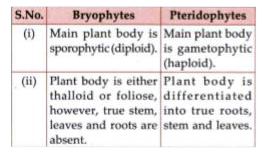Naked seeded plants differ from bryophytes and pteridophytes in
Possessing true stem,root and leaves
Absence of fertilisation through pollen tube
Absence of independent free living gametophytes
Presence of non-integumented megasporangium
Step-by-Step Solution:
1. Identify the Groups of Plants:
- Naked seeded plants are known as Gymnosperms.
- Bryophytes include mosses and liverworts.
- Pteridophytes include ferns and horsetails.
2. Vascular Structure:
- Gymnosperms are vascular plants, meaning they have specialized tissues (xylem and phloem) for the transport of water, nutrients, and food.
- Bryophytes and pteridophytes are non-vascular or less vascular, which limits their size and structure.
3. True Roots, Stems, and Leaves:
- Gymnosperms possess true roots, stems, and leaves that are well-developed.
- In contrast, bryophytes have simple structures without true roots, stems, or leaves, and pteridophytes have simpler structures compared to gymnosperms.
4. Gametophyte Generation:
- Gymnosperms do not have independent free-living gametophytes; instead, their gametophytes are dependent on the sporophyte.
- Bryophytes and pteridophytes have independent free-living gametophytes.
5. Fertilization Mechanism:
- Gymnosperms use pollen tubes for fertilization, which is a characteristic feature.
- Pteridophytes also utilize pollen tubes for fertilization, while bryophytes do not.
6. Megasporangium Structure:
- Gymnosperms have integumented megasporangia, while bryophytes have non-integumented megasporangia.
7. Conclusion:
- The primary difference is that Gymnosperms possess true roots, stems, and leaves, which are well-developed, unlike bryophytes and pteridophytes.
Final Answer: Naked seeded plants (Gymnosperms) differ from bryophytes and pteridophytes primarily in possessing true roots, stems, and leaves.
---
- Naked seeded plants are known as Gymnosperms.
- Bryophytes include mosses and liverworts.
- Pteridophytes include ferns and horsetails.
- Gymnosperms are vascular plants, meaning they have specialized tissues (xylem and phloem) for the transport of water, nutrients, and food.
- Bryophytes and pteridophytes are non-vascular or less vascular, which limits their size and structure.
- Gymnosperms possess true roots, stems, and leaves that are well-developed.
- In contrast, bryophytes have simple structures without true roots, stems, or leaves, and pteridophytes have simpler structures compared to gymnosperms.
- Gymnosperms do not have independent free-living gametophytes; instead, their gametophytes are dependent on the sporophyte.
- Bryophytes and pteridophytes have independent free-living gametophytes.
- Gymnosperms use pollen tubes for fertilization, which is a characteristic feature.
- Pteridophytes also utilize pollen tubes for fertilization, while bryophytes do not.
- Gymnosperms have integumented megasporangia, while bryophytes have non-integumented megasporangia.
- The primary difference is that Gymnosperms possess true roots, stems, and leaves, which are well-developed, unlike bryophytes and pteridophytes.
Topper's Solved these Questions
Similar Questions
Knowledge Check
Common between bryophytes and pteridophytes is
AAbsence of sporophyteBGametophyte dependent on sporophyteCSporophyte dependent on gametophyteDMulticellular sex organs with sterile jacket.Naked seeded plants are called
ABryophyteBAngiospermCGymnospermDAlgaeBryophytes differ from pteridophytes in
Ahaving mitosporesBthe absence of vascular tissue systemClacking embryo stageDall of the stage
Pteridophytes differ from bryophytes in possessing
View SolutionPteridophytes differ from bryophytes in having
View SolutionPteridophytes differ from bryophytes and thallophytes in having
View SolutionWhat is common between bryophytes and pteridophytes ?
View SolutionPteridophytes differ from bryophytes in possessing:
View Solution


